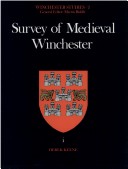Winchester Studies
2 primary works
Book 1
Winchester in the Early Middle Ages
by Frank Barlow, Martin Biddle, Olof von Feilitzen, and D.J. Keene
Published 6 January 1976
London and Winchester were not described in the Domesday Book, but the royal properties in Winchester were surveyed for Henry I about 1110 and the whole city was surveyed for Bishop Henry of Blois in 1148. These two surveys survive in a single manuscript, known as the Winton Domesday,...Read more
London and Winchester were not described in the Domesday Book, but the royal properties in Winchester were surveyed for Henry I about 1110 and the whole city was surveyed for Bishop Henry of Blois in 1148. These two surveys survive in a single manuscript, known as the Winton Domesday, and constitute the earliest and by far the most detailed description of an English or European town of the early Middle Ages. In the period covered Winchester probably achieved the peak of its medieval prosperity. From the reign of Alfred to that of Henry II it was a town of the first rank, initially centre of Wessex, then the principal royal city of the Old English state, and finally 'capital' in some sense, but not the largest city, of the Norman Kingdom. In this book a team of scholars from Britain and Sweden, centred on the Wincheste Research Unit have undertaken a full edition, translation, and analyses of the surveys and of the city they depict.
Drawing on the evidence derived from archaeological excavation and historical research in the city since 1961, on personal- and place-name evidence, and on the recent advances in Anglo-Saxon numismatics, they provide an unparalleled account of one of the principal European cities of the eleventh and twelfth centuries.
Drawing on the evidence derived from archaeological excavation and historical research in the city since 1961, on personal- and place-name evidence, and on the recent advances in Anglo-Saxon numismatics, they provide an unparalleled account of one of the principal European cities of the eleventh and twelfth centuries.
Book 2
By the fourteenth century Winchester had lost its former eminence, but in trades, manufactures, and population, as well as by virtue of its administrative and ecclesiastical role, the city was still one of the major provincial centres in England. This Survey is based on a reconstruction of the histories...Read more
By the fourteenth century Winchester had lost its former eminence, but in trades, manufactures, and population, as well as by virtue of its administrative and ecclesiastical role, the city was still one of the major provincial centres in England. This Survey is based on a reconstruction of the histories of the houses, plots, gardens, and fields in the city and suburbs between c. 1300 and c. 1540, although in many instances both earlier and later periods are also covered. The reconstruction takes the form of a gazetteer (Part ii) of 1,128 histories of properties, together with accounts of 56 parish churches and the international fair of St. Giles, all illustrated by detailed maps. There is also a biographical register (Part iii) concerning more than 8,000 property-holders, most of whom lived in Winchester. This is the first time that it has been possible to piece together such a precise and detailed picture of both the topgraphy and the inhabitants of a medieval town.
Part i of the book contains a full discussion of the significance of this material and, in a manner relevant to an understanding of life in medieval towns in general, describes and defines such matters as the evolution of the physical environment, housing, land-tenure, property values, the parochial structure, the practice and organization of trades, and the ways in which the citizens of Winchester adapted to the declining status of their city.
Part i of the book contains a full discussion of the significance of this material and, in a manner relevant to an understanding of life in medieval towns in general, describes and defines such matters as the evolution of the physical environment, housing, land-tenure, property values, the parochial structure, the practice and organization of trades, and the ways in which the citizens of Winchester adapted to the declining status of their city.

